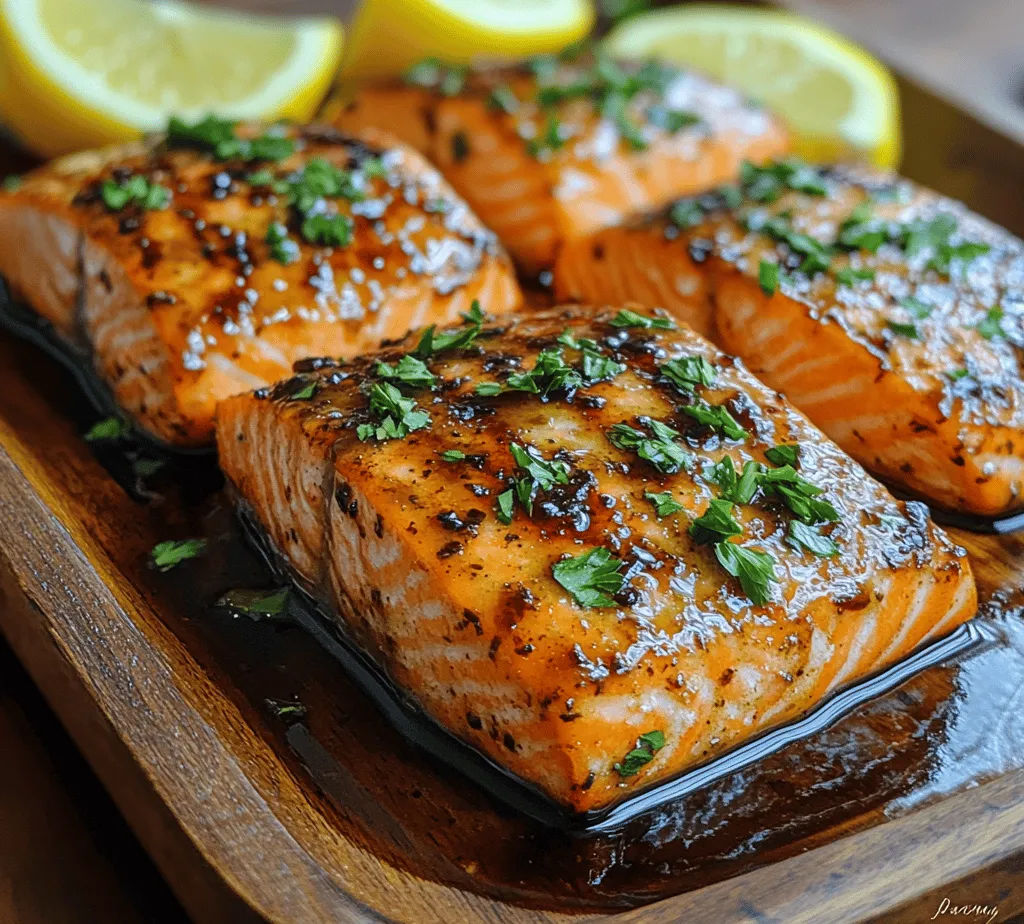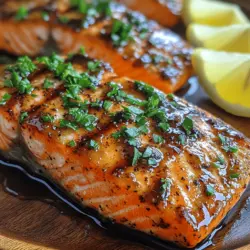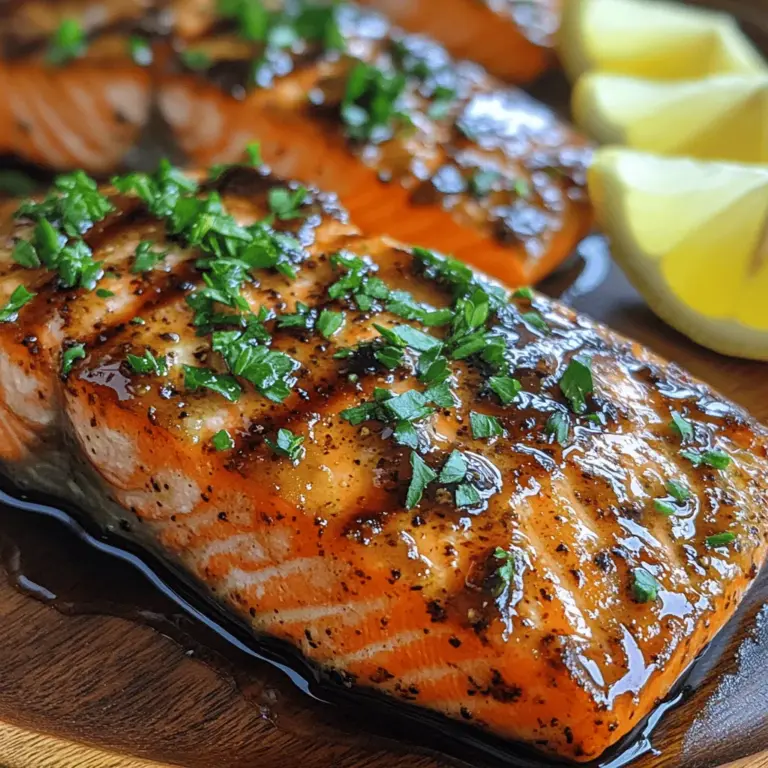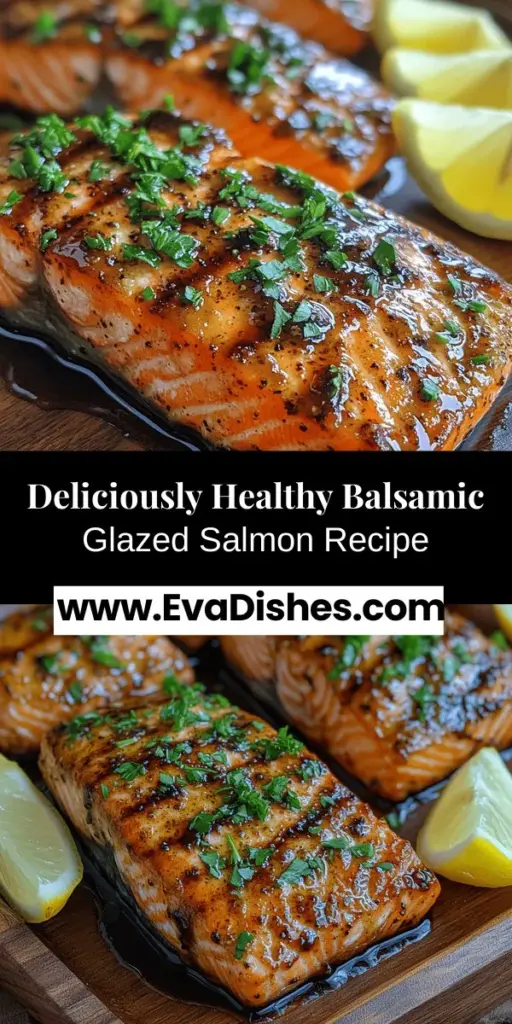Introduction
In the world of culinary delights, few dishes are as versatile and satisfying as salmon. This fish, celebrated for its rich, buttery flavor and tender texture, can be prepared in countless ways, making it a staple in kitchens around the globe. When paired with a sweet and tangy balsamic glaze, salmon transforms into an extraordinary dish that is both sophisticated and accessible. Whether you’re a busy professional looking for a quick weeknight meal or a culinary enthusiast eager to impress guests at a dinner party, Balsamic Glazed Salmon is sure to hit the mark.
This article will delve into the enticing recipe for Balsamic Glazed Salmon, exploring its ingredients, preparation methods, and health benefits. With its ease of preparation and delightful flavor profile, this dish promises to be an impressive addition to your dinner repertoire.
The Allure of Balsamic Glazed Salmon
Understanding the appeal of balsamic glazed salmon is essential to appreciating its place in contemporary cuisine. The combination of salmon and balsamic vinegar creates a delightful symphony of flavors that tantalizes the taste buds. The natural richness of the salmon is complemented by the sweet and tangy notes of the balsamic glaze, resulting in a dish that is both satisfying and sophisticated.
Moreover, this dish provides numerous health benefits. Salmon is renowned for its high levels of omega-3 fatty acids, which are essential for heart health and brain function. The inclusion of balsamic vinegar, known for its antioxidant properties, further enhances the nutritional profile of this meal. Together, these ingredients create a dish that not only tastes great but also supports overall well-being.
The Ingredients: Building Blocks of Flavor
Overview of Key Ingredients
To prepare Balsamic Glazed Salmon, you’ll need a handful of essential ingredients that work together to create a flavorful dish. The primary components include:
– Salmon fillets: Fresh, high-quality salmon is crucial for the best results. Opt for wild-caught if possible, as it’s often more flavorful and sustainable.
– Balsamic vinegar: This is the star of the dish, providing the signature glaze that balances sweetness and acidity.
– Honey: A natural sweetener that enhances the balsamic vinegar’s flavor while adding a touch of richness.
– Dijon mustard: This ingredient adds depth to the glaze, contributing a subtle heat and complexity.
– Fresh herbs: Herbs such as rosemary or thyme elevate the dish with their aromatic qualities.
– Garlic: Fresh garlic adds an additional layer of flavor, enhancing the overall taste profile.
Nutritional Benefits of Salmon
Salmon is often lauded as one of the healthiest fish options available. Rich in high-quality protein, it provides essential amino acids required for muscle building and repair. Additionally, salmon is packed with omega-3 fatty acids, which have been shown to reduce inflammation, lower blood pressure, and decrease the risk of heart disease. It’s also a great source of vitamins B12 and D, selenium, and potassium, making it a powerhouse of nutrition.
Incorporating salmon into your diet can support cognitive function, promote healthy skin, and contribute to overall well-being. With Balsamic Glazed Salmon, you not only indulge in a delicious meal but also take a step toward healthier eating.
The Role of Balsamic Vinegar in Cooking
Balsamic vinegar, originating from the Modena region of Italy, is a beloved ingredient in many culinary traditions. Its complex flavor profile, marked by sweetness and acidity, makes it a versatile addition to various dishes—from salads to roasted vegetables and marinades. In the context of our salmon dish, balsamic vinegar serves as the foundation of the glaze, imparting a unique flavor that enhances the natural richness of the fish.
When reduced into a glaze, balsamic vinegar thickens and intensifies in flavor, making it an ideal complement to salmon. The caramelization that occurs when the glaze is applied during cooking adds a beautiful sheen and a delightful crunch to the dish, elevating it from simple to extraordinary.
Importance of Honey and Dijon Mustard
Honey and Dijon mustard play critical roles in creating the perfect glaze for our salmon. Honey adds a natural sweetness that balances the acidity of the balsamic vinegar, resulting in a harmonious blend of flavors. Its viscosity helps the glaze adhere to the salmon, ensuring that each bite is bursting with flavor.
Dijon mustard, on the other hand, introduces a tangy zest that elevates the glaze’s complexity. The mustard’s slight heat complements the sweetness of the honey and the acidity of the vinegar, creating a well-rounded flavor profile that enhances the salmon without overpowering it.
The Significance of Fresh Herbs and Garlic
Fresh herbs and garlic are essential for adding depth and dimension to the Balsamic Glazed Salmon. Herbs such as rosemary or thyme not only contribute aromatic qualities that enhance the sensory experience of the dish but also provide additional health benefits. These herbs are rich in antioxidants and have anti-inflammatory properties, making them a wonderful complement to the omega-3 fatty acids found in salmon.
Garlic is another powerhouse ingredient that brings both flavor and health benefits to the dish. Known for its immune-boosting properties and potential cardiovascular benefits, garlic adds a pungent, savory note that balances the sweetness of the glaze.
Preparation: Crafting the Perfect Marinade
Step-by-Step Guide to Making the Marinade
Creating the marinade for Balsamic Glazed Salmon is straightforward and requires just a few simple steps. Here’s how to craft the perfect marinade:
1. Gather Ingredients: Start by gathering all the necessary ingredients—balsamic vinegar, honey, Dijon mustard, minced garlic, and chopped fresh herbs.
2. Mix the Marinade: In a small bowl, combine the balsamic vinegar, honey, Dijon mustard, minced garlic, and a pinch of salt and pepper. Whisk together until the mixture is smooth and well blended.
3. Marinate the Salmon: Place the salmon fillets in a shallow dish or a resealable plastic bag. Pour the marinade over the salmon, ensuring that each piece is well coated. Cover the dish with plastic wrap or seal the bag, and refrigerate for at least 30 minutes, allowing the flavors to penetrate the fish.
4. Reserve Some Marinade: If desired, reserve a small portion of the marinade before adding it to the salmon. This can be used later to brush on the salmon during cooking for an extra layer of flavor.
Tips for Achieving the Right Balance of Flavors
Achieving the right balance of flavors in your marinade is crucial for the success of the dish. Here are some tips to ensure your Balsamic Glazed Salmon is perfectly seasoned:
– Taste as You Go: Always taste the marinade before adding it to the salmon. Adjust the sweetness or acidity by adding more honey or balsamic vinegar to suit your palate.
– Consider Freshness: Fresh herbs and garlic will yield a more vibrant flavor compared to dried alternatives. Always opt for fresh whenever possible.
– Marinate Wisely: While marinating for at least 30 minutes will impart flavor, you can marinate the salmon for up to two hours for a more pronounced taste. However, avoid marinating for too long, as the acidity in the vinegar can begin to break down the fish’s texture.
The Importance of Marinating Time
Marinating is not just about infusing flavor; it’s also about enhancing the overall texture of the salmon. The marinade helps to tenderize the fish, resulting in a moist and succulent final dish. The ideal marinating time is typically between 30 minutes to two hours, depending on your schedule and flavor preference.
During this time, the salmon absorbs the flavors of the marinade, allowing the sweet and tangy notes to permeate the flesh. However, keep in mind that marinating for too long can lead to a mushy texture due to the acidic nature of the balsamic vinegar. Therefore, it’s essential to find that sweet spot to achieve the best results.
Cooking Methods: Grilling vs. Baking
When it comes to preparing Balsamic Glazed Salmon, you have several cooking methods at your disposal. The two most popular options are grilling and baking, each offering unique benefits.
Advantages of Grilling Salmon
Grilling is a fantastic way to cook salmon, as it imparts a delicious smoky flavor and creates a beautiful char on the outside while keeping the inside tender and flaky. Here are some advantages of grilling:
– Flavor: The high heat of the grill caramelizes the sugars in the balsamic glaze, resulting in a rich, complex flavor that is hard to replicate with other cooking methods.
– Texture: Grilling creates a delightful crust on the salmon, enhancing its texture and making each bite satisfying.
– Quick Cooking: Grilling salmon is a quick process, allowing you to prepare a delicious meal in under 15 minutes.
– Outdoor Experience: If the weather permits, grilling allows you to enjoy the outdoors while cooking, making it a perfect option for summer gatherings or family dinners.
In the next part of this article, we will explore the baking method for Balsamic Glazed Salmon, along with additional tips for perfecting this delightful dish. Stay tuned for more culinary insights and techniques!

Step-by-Step Instructions for Grilling Balsamic Glazed Salmon
Grilling is one of the most popular methods for preparing salmon, and for good reason. The high heat of the grill enhances the flavors of the Balsamic glaze, allowing the fish to develop a beautiful char and smoky aroma. Here’s how to grill your Balsamic Glazed Salmon to perfection:
1. Preheat the Grill: Start by preheating your grill to medium-high heat (about 375°F to 400°F). This ensures that the salmon cooks evenly and achieves those beautiful grill marks.
2. Prepare the Grill Grates: To prevent sticking, brush the grill grates with oil using a paper towel dipped in vegetable oil. This will help achieve a nice sear on the salmon.
3. Remove Excess Marinade: Take the marinated salmon fillets out of the zip-top bag and allow any excess marinade to drip off. This will help prevent flare-ups from excess sugars in the glaze.
4. Place Salmon on the Grill: Lay the salmon fillets skin-side down directly on the grill grates. This will help keep the fish moist and tender while preventing it from falling apart.
5. Grill the Salmon: Close the lid and grill the salmon for about 6-8 minutes, depending on the thickness of the fillets. Avoid moving the fish around; let it cook undisturbed to develop a good sear.
6. Flip the Salmon: Using a fish spatula, carefully flip the salmon over and grill for an additional 4-6 minutes. The salmon is done when it flakes easily with a fork and has reached an internal temperature of 145°F.
7. Apply Additional Glaze: During the last minute of grilling, brush the salmon with a bit more of the Balsamic glaze for added flavor and a glossy finish.
8. Remove and Rest: Once cooked, remove the salmon from the grill and let it rest for about 5 minutes. This allows the juices to redistribute, ensuring a moist and flavorful bite.
Baking Salmon: A Convenient Alternative
If grilling isn’t an option or you prefer a more hands-off approach, baking is an excellent alternative for preparing Balsamic Glazed Salmon. This method is perfect for busy weeknights or when cooking for a larger group. Here’s how to bake your salmon:
1. Preheat the Oven: Preheat your oven to 400°F. This temperature is ideal for cooking salmon evenly without drying it out.
2. Prepare the Baking Dish: Lightly grease a baking dish with cooking spray or olive oil. This will prevent the salmon from sticking and make for easier cleanup.
3. Arrange the Salmon: Place the marinated salmon fillets in the prepared baking dish, skin-side down. If desired, you can pour any remaining marinade over the top for added flavor.
4. Bake the Salmon: Bake in the preheated oven for 12-15 minutes, or until the salmon is opaque and flakes easily with a fork. The internal temperature should reach 145°F.
5. Broil for a Glazed Finish: For a caramelized top, switch the oven to broil during the final 2-3 minutes of cooking. Watch closely to prevent burning.
Comparison of Cooking Times and Techniques
When comparing grilling and baking, both methods offer unique advantages. Grilling provides a smoky flavor and beautiful sear, while baking is more forgiving and offers a consistent cook throughout the fillet. Here’s a quick summary:
– Grilling:
– Time: 10-14 minutes total (6-8 minutes skin-side down, 4-6 minutes flipped)
– Flavor: Smoky, charred exterior
– Texture: Crisp outside, tender inside
– Baking:
– Time: 12-15 minutes total
– Flavor: Rich, with the option to enhance with broiling
– Texture: Tender throughout, slightly less crisp
Finishing Touches: Creating the Perfect Glaze
To achieve the ultimate flavor and texture with your Balsamic Glazed Salmon, mastering the glaze is crucial. Here’s how to thicken the marinade for maximum flavor:
1. Simmer the Marinade: After marinating the salmon, pour the remaining marinade into a small saucepan. Bring it to a boil over medium heat, then reduce to a simmer.
2. Thicken the Glaze: Allow the marinade to simmer for about 5-10 minutes, or until it reduces by half and becomes syrupy. This concentrates the flavors and enhances the sweetness of the balsamic vinegar.
3. Cool Before Use: Once thickened, let the glaze cool slightly before using it to brush on the salmon. This prevents it from burning during cooking and ensures a glossy finish.
Serving Suggestions: Presentation and Pairings
Presentation is key when serving Balsamic Glazed Salmon. Here are some tips for making your dish visually appealing and suggestions for perfect pairings:
– Plate Presentation: Serve the salmon fillets atop a bed of sautéed greens (such as spinach or kale) or alongside roasted vegetables (like asparagus or carrots). Drizzling extra balsamic glaze over the top adds a beautiful finishing touch.
– Side Dishes: Complement the dish with light, fresh options like quinoa salad, wild rice pilaf, or a citrusy coleslaw. These sides provide a contrast in texture and flavor while enhancing the overall meal.
– Garnishing: Add fresh herbs, such as chopped parsley or basil, to the plate for a pop of color and freshness. Lemon wedges on the side add a hint of acidity that cuts through the richness of the salmon.
The Importance of Garnishing with Fresh Ingredients
Garnishing is not just about aesthetics; it elevates the entire dining experience. Fresh ingredients contribute to the dish’s flavor profile and can enhance its visual appeal. Consider adding:
– Herbs: Bright herbs like cilantro or dill can provide a fresh note that complements the savory sweetness of the salmon.
– Citrus Zest: A sprinkle of lemon or lime zest adds brightness and an aromatic touch.
– Microgreens: These delicate greens can be used for a refined finish, adding both flavor and an elegant look.
Health Benefits of Balsamic Glazed Salmon
In addition to its delicious flavor, Balsamic Glazed Salmon offers numerous health benefits, making it a smart choice for any meal.
Omega-3 Fatty Acids: Heart Health and Metabolism
Salmon is renowned for its high content of omega-3 fatty acids, which are essential for heart health. These healthy fats can help reduce inflammation, lower blood pressure, and improve cholesterol levels. Regular consumption of omega-3s is linked to a lower risk of heart disease and improved metabolic function.
Antioxidants in Balsamic Vinegar
Balsamic vinegar is not only a flavorful addition but also a source of antioxidants. These compounds help combat oxidative stress in the body, which can lead to chronic diseases. Incorporating balsamic vinegar into your diet can support overall health and well-being.
The Role of Honey in a Balanced Diet
Honey, a key ingredient in the glaze, provides natural sweetness and offers various health benefits. It has antibacterial properties and can help soothe digestive issues. Additionally, honey is a healthier alternative to refined sugars, making it a great choice for balancing flavors in your dish.
Versatility of Balsamic Glazed Salmon
One of the best aspects of Balsamic Glazed Salmon is its versatility. Whether you’re meal prepping or adapting the recipe for dietary preferences, this dish can easily fit into various lifestyles.
Meal Prep and Leftovers: How to Store and Reheat
For those who love meal prepping, Balsamic Glazed Salmon is an excellent option. Here’s how to store and reheat leftovers:
– Storage: Place any leftover salmon in an airtight container and refrigerate for up to 3 days.
– Reheating: To reheat, place the salmon in a preheated oven at 350°F for about 10 minutes or until warmed through. Alternatively, you can microwave it on low power for 1-2 minutes, being careful not to overcook.
Pairing Options: Sides That Complement the Dish
Balsamic Glazed Salmon pairs wonderfully with a variety of sides. Here are some suggestions:
– Vegetable Medley: Roasted or steamed vegetables such as zucchini, bell peppers, and Brussels sprouts add color and nutrition.
– Grains: Quinoa, brown rice, or farro provide a hearty base that complements the salmon while adding fiber to your meal.
– Salads: A fresh garden salad with mixed greens, cherry tomatoes, and a light vinaigrette balances the richness of the salmon.
Adapting the Recipe for Dietary Preferences (e.g., Gluten-Free, Low-Carb)
This recipe can easily be adapted to suit various dietary needs:
– Gluten-Free: Ensure that the balsamic vinegar and any additional sauces used are labeled gluten-free.
– Low-Carb: Pair the salmon with non-starchy vegetables and omit any high-carb sides for a low-carb meal.
– Paleo/Keto: Replace honey with a low-carb sweetener like erythritol or stevia to keep the glaze compliant with keto or paleo diets.
Conclusion
Balsamic Glazed Salmon is not just a dish; it’s a celebration of flavors and health. By combining simple ingredients and easy cooking techniques, this recipe allows anyone to create a restaurant-quality meal at home. The balance of sweet and savory, along with the health benefits of salmon, makes this dish a must-try for anyone looking to enhance their culinary skills. Whether served at a family dinner or a special gathering, this salmon recipe is sure to impress and satisfy. Enjoy the culinary journey that comes with preparing Balsamic Glazed Salmon, and relish the delicious outcomes of your efforts.


